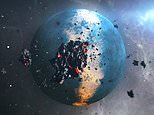
advertisement
The idea of a deadly asteroid crashing into Earth may sound like the plot of the latest sci-fi blockbuster. But it could become a reality, with a roughly 1 in 300,000 chance of a deadly asteroid hitting Earth each year, according to NASA. Before you panic about impending doom, there’s good news.
Scientists from the University of Murcia have come up with a formula to discover killer asteroids heading towards our planet. Professor Oscar del Barco Novillo’s equation is based on the gravitational bending of light, which allows scientists to determine the exact location of small objects in the solar system. This includes objects in the Kuiper Belt, a region of icy objects including Pluto and other dwarf planets outside Neptune’s orbit, and a vast frozen region called the Oort Cloud, the most distant region in the solar system. Contains a spherical shell.
As a result, planetary defense networks could be able to detect and prepare for asteroids that could hit Earth. This advance warning could be the difference between having time to divert the asteroid to a safe path and a catastrophe. Normally, light follows a straight path from an object to our eyes. In other words, where we see the image is where the object actually exists. However, this is not the case for distant objects like asteroids due to a phenomenon called “gravitational deflection.” When a ray of light passes through a strong gravitational field, such as around the sun, it leaves a straight path and follows a curved trajectory. You can think of it like a ball rolling in a curved line over uneven ground. The idea that gravity could bend light rays passing through it was first proposed by Sir Isaac Newton in 1730.
But it wasn’t until Albert Einstein proposed his general theory of relativity in 1916 that scientists were able to confirm that this was indeed the case. The problem for astronomers is that due to gravitational biases, the image we see of a distant object doesn’t match the object’s actual location. Professor Novillo told MailOnline: “When sunlight reflects off small objects in our solar system, such as asteroids, the rays we receive on Earth are deflected by the sun or major planets like Jupiter. “In this sense, Since the actual positions of these small bodies are shifted, this effect must be taken into account in the equations of motion of these small bodies.
In most applications this may not be a problem, but when calculating the trajectory of a potentially dangerous asteroid, even a small miscalculation can be fatal. Professor Novillo’s solution, published in the Monthly Notices of the Royal Astronomical Society, is to treat gravity as if it were a physical medium like water and calculate how much light bends as it passes through it. Professor Nobilo used this formula to calculate the deflection angle of a ray coming from Mercury at various points in its orbit.
Comparing this result with those based on Newton’s and Einstein’s equations, they found a difference of up to 15.8% when Mercury is at its furthest from the Sun. Professor Nobilo said the most important outcome of the discovery is that it will allow for “better calculations of the orbits of small objects in our solar system that are potentially dangerous to Earth.” Although it does not help in detecting asteroids in the first place, it can help in determining more precise locations of these objects and, as a result, in estimating their orbits more accurately. Space agencies such as NASA and the European Space Agency (ESA) are currently researching ways humans can avoid collisions with asteroids. For example, ESA’s DART mission crashed a satellite the size of a refrigerator into the space rock Dimorphos to see if it would knock the asteroid out of its path.
This result will be confirmed by the Hera mission late next year, but early observations indicate that the impact did indeed cause Dimorphos to miss its orbit. In theory, humans could use similar kamikaze satellites to deflect dangerous asteroids toward Earth. But doing this would require years of advance warning to give space agencies time to plan their missions and for the asteroid to veer off Earth’s path. That’s why it’s so important for space agencies to have a way to accurately assess the positions and orbits of asteroids as they drift through the solar system. Beyond planetary defense, this equation can also be used to improve our understanding of the universe.
It is hoped that scientists will be able to calculate the exact location of Proxima Centauri, the closest star to Earth. Proxima Centauri is 4.25 light-years away and three exoplanets are thought to orbit around it. Determining their positions accurately would also help scientists study the planets’ orbits precisely and learn whether those planets are actually within the star’s habitable zone. Additionally, Professor Nobilo’s discoveries could also help scientists map the most distant reaches of the universe.
Professor Nobilo said: “Distant galaxies that are distorted and expanded by large intervening masses, such as galaxy clusters, could be precisely located using this new precise equation.” states. Over the next six years, ESA’s Euclid mission will observe the shapes, distances, and movements of billions of galaxies across 10 billion light-years, with the goal of creating the largest 3D map of the universe ever created. Masu. Using this equation, scientists may be able to create even more precise maps to help understand how dark matter and dark energy have shaped the universe into the way we see it today. I don’t know.
Want more articles like this from Daily Mail? Visit our profile page and hit the follow button above for more news you want.


